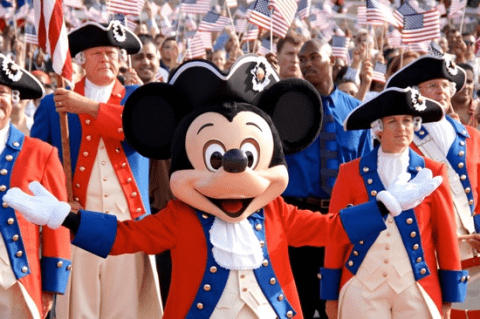
While this may seem like a newer concept, this question has actually existed as long as Disney parks…
When we think of theme parks—especially Disneyland and Walt Disney World—we usually think of magic brought to life. These are places where the fantastical becomes real, where guests can escape to an idealized world of adventure, creative expression, and wonder.
The legacy of Disney parks isn’t just one of magic, however—Disney also has a rich history of making learning fun.
Particularly at places like Epcot and Disney’s Animal Kingdom, guests are encouraged not just to enjoy the awe of a theme park but to embrace opportunities to learn. Across their history, Disney has used their lands and attractions to stoke curiosity in the next generation for science, conservation, culture, geography, animal sciences, and history. Epcot, in particular, has treated guests to incredible explorations of the histories of communication, transportation, technology, and America itself.
The problem is what happens when history becomes controversial?
I considered this question on a recent visit to the Civil War memorial at Lookout Mountain & Chattanooga—as I read the struggles of soldiers on both sides who participated in the battles there, I considered the matter of controversial history. Questions surrounding the handling of Civil War monuments have been hot topics in previous years—a debate far more complex than I intend to touch here.
Still, it got me thinking about how the issue applies to theme parks. It’s one thing discussing landmarks and monuments in the real world—but what about controversial history or subjects in theme parks? Are places like Disney parks supposed to be free from such cares, expressing a world purposefully idealized, or is there a place in theme parks to spark discussion about controversial history that can lead to education and growth?
A note before we proceed: I write a fair amount of “concrete” style content like current park updates, tips & tricks to improve future vacations, and even explorations of current culture issues, like the treatment of Disney cast members in the midst of a pandemic. This is a more abstract subject—the goal is not to promote any particular agenda but simply to explore an interesting subject related to theme parks and perhaps stoke some rich discussion. For those who join the conversation in comments or on social media, let’s do our best to keep the discussion civil, respecting that there may be many different points of view.
The infamous tale of the burning cabin
Change is inevitable, and over the years, Disney has periodically updated attractions—sometimes due to cases when content no longer rings well with culture and Disney has had to adapt. Sometimes these subjects have to do with matters of cultural sensitivity, but the question becomes especially pertinent when it comes to controversial history. We’ll explore several such cases, but few are as enigmatic as the story of the Burning Settler’s Cabin.
Back in the days of yore (that is post 1956 after Disneyland opened), guests touring the Rivers of America could observe the sad tale of the Burning Settler’s Cabin. The cabin was exactly what it sounds like—a perpetually burning cabin (using the same fire effect used in Pirates of the Caribbean) belonging to a dead settler.
According to the original story, the cabin sat at the center-point between a tribe of friendly Indians and a tribe of unfriendly Indians. Unfortunately, the settler planted his cabin on the wrong side of the river and ran afoul of his less-hospitable neighbors—indeed, guests could see his body lying nearby pierced with an arrow. This theme was originally gleaned from Davy Crockett.
By the 1970’s, Disney realized the story of the cabin painted a rather-too-bleak picture, particularly in its oversimplification of the complex history of Native American cultures and conflicts with American settlers. Disney adjusted the story to make the settler the victim of river pirates, removing the arrow as a clarification. In the 1980’s, the story shifted to claim the fire was a result of exploding moonshine and that the unconscious moonshiner was just really, really drunk rather than dead. The tale changed again in the 90’s to simply state that a careless settler burned his own house down (and endangered a nearby eagle nest? Weird twist).
By the 2000’s, the burning element vanished forever—the cabin became a simple settler’s cabin. By 2010, the cabin was transformed into the home and place of business of Mike Fink, an eccentric trapper. It looked like Mike’s cabin would be gone forever in 2017, but after construction on refurbishing the Rivers of America was complete, it was revealed the cabin survived. On a side note, Walt Disney World had a burning cabin too with some similar history, only it still looks derelict.
The story of the burning cabin is interesting because it reflects so many of the changes in American perceptions of history over the decades. Looking back at the original controversial story, you could argue that there certainly was real historical conflict between American settlers and Native American tribes—but as culture engaged this conversation more and more, it became clear to Disney that their take had grown outdated and tone deaf.
Even the adjustments to stories about pirates and moonshiners didn’t survive the passage of time—ultimately, Disney decided to step back from the controversy entirely, opting for a reasonably safe solution.
Other well-known Disney ride refurbishments (due to controversy)
Another good example of this subject comes from one of Disney’s most popular rides. Pirates of the Caribbean has gone through more transformations over the years than just about any other major Disney attraction—several of which have been tied to controversy related to the history of pirates.
It would be difficult to track all of these, but the first major shift took place in 1997. In the original iteration of the attraction, lascivious pirates chased townswomen through the burning town, and a young woman hiding in a barrel from a particularly lusty pirate (some of the concept art for the ride was even more racy). The ride was adjusted to portray angry female townswomen chasing the pirates off, who seemed more focused on plundering food than maidens for the wench auction (which was still a thing). The girl in the barrel was replaced by a cat, and the lusty pirate became a gluttonous pirate instead.
A related change to Pirates of the Caribbean arrived in 2017-2018, when the Bride Auction was replaced with a loot auction instead. The well-dressed “Redhead” who had once been the object of desire at that auction became a Grace O’Malley-style pirate auctioneer. The change was uniquely controversial, though it seems fans have warmed up to the new incarnation of “Redd” more and more as time has passed. She’s even become a wandering character in the park.
Pirates is another interesting case in this study. Unlike the Rivers of America, which one could argue perhaps has a more historical focus, Disney’s depiction of life on the high seas in Pirates of the Caribbean has always been uniquely fantastical--leaning heavily towards the swashbuckling image of pirates instead of the more accurate history of pirates as… well, pirates—thieves, pillagers, and generally men-of-low-moral-fiber.
As culture has engaged in more conversations regarding the serious nature of the exploitation of women (especially trafficking), it makes sense that Disney ultimately had to make some choices regarding which direction to take the ride, leaning towards the fantastical rather than attempting to tow the line to maintain a bawdy element of the ride’s original humor.
There are several other examples in the same arena. Kilimanjaro Safaris used to have a storyline focused on poachers’ efforts to capture a young elephant. While poaching is certainly a real threat—one potentially worthy of exploration in an edutainment attraction—the story was ultimately deemed too dark for the ride. You can still see minor elements left over from it in the current ride.
Most recently, Disney has shared plans to update several rides due to controversial representations and history. The Jungle Cruise is under a long term update to adjust its story (partially tied to representation and history issues, though by and large the shift seems more focused on introducing a richer story involving S.E.A.), and most notably, Disney has announced plans to update Splash Mountain to be rethemed after the film The Princess and the Frog rather than the notoriously controversial film, Song of the South. The Splash Mountain update has proven the more controversial of the two both due to the ride’s classic nature and the fact that, in the past, Splash Mountain managed to stay distant from the sketchier problems tied to Song of the South. Despite this, it appears the issue of controversial history finally has caught up to the famous ride (even if it could be argued that The Princess and the Frog could make a worthy successor for the attraction).






Comments
Oh Brett how naive of you, cancel culture means wipe the slate clean, it never happened. What you are suggesting is compromise which is a four letter world to the mob. Your wise idea makes perfect sense to the unwoke crowd, how silly of us.
I find the decision to change Splash Mountain from "Song of the South" to "The Princess and the Frog" a shame. Now do not get me wrong, I understand the issues with Uncle Remus and the racism that is incorporated in that character's history. But as someone that also understands the history of the stories in question, I find this move to actually be contrary to the stated desire to be more culturally inclusive.
The folk stories in question are African in origin, that were brought over here by the enslaved African community and passed down orally in the south until they were collected by Joel Chandler. Stories that might have been lost to time if he had not collected them and would not have been known by a broader audience if not for Walt Disney.
So now we are pulling out the African folk tales because of ignorance of history and replacing it with "The Princess and The Frog". A story that at its roots is based on a European fairy tale, that was reimagined by putting an African-American face on it. There is a term, that could be considered a derogatory, that describes a white person being made up an African-American, that could apply to what was done to this story.
So the question to me is it better to have a ride that exposes people to stories that have true African roots or one that is based on a European fairy-tale that is pretending to be what it is not.
In the case of Splash Mountain, I'd say the ride has the best storytelling and music of any Disney attraction and it's a shame to change it. It has none of the problematic features of the film it's derived from, and The Princess and the Frog doesn't contain any music that can replace How Do You Do or Zip-a-dee-doo-dah.
A better (and likely cheaper) solution would have been for Disney to make a new Brer Rabbit feature, one free of Uncle Remus and the plantation, and featuring a mostly black cast. I'm a little surprised this hasn't been considered.
That's a great idea Brett. Especially if it were traditional hand drawn animation rather than computer animated.
I also think it's a disservice to Tiana to just repurpose an existing ride. I think Princess and the Frog deserves its own brand new ride rather than being assigned to an old one.